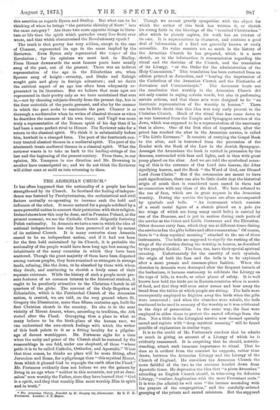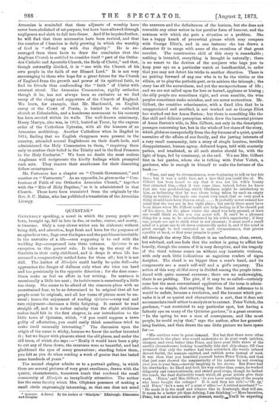THE ARMENIAN CHURCH.* IT has often happened that the nationality
of a people has been strengthened by its Church. In Scotland the feeling of indepen- dence was fostered by Presbyterianism, the ecclesiastical and civil factors mutually co-operating to increase each the hold and influence of the other. It seems natural for a people subdued by a more powerful nation to connect their patriotism with their religion. Ireland shows how this may be done, and in Prussian Poland, at the present moment, we see the Catholic Church diligently fostering Polish nationality. In Armenia we have a case in which the idea of national independence has only been preserved at all by means of its national Church. It is many centuries since Armenia ceased to be an independent nation, and if it had not been for the firm hold maintained by its Church, it is probable the nationality of the people would have been long ago lost among the inhabitants of the many countries in which they have been scattered. Though the great majority of them have been dispersed among various peoples, they have remained as strangers in strange lands, refusing, like the Jews, to be absorbed by those with whom they dwelt, and continuing to cherish a lively sense of their separate existence. While the history of such a people must pre- sent features of no common interest to the historical student, it ought to be peculiarly attractive to the Christian Church in all quarters of the globe. The convent of the Only-Begotten at Echmiadzin, which is the Patriarchal Church of the Armenian nation, is erected, we are told, on the very ground where St. Gregory the Illuminator, more than fifteen centuries ago, built the first Christian church in the country. Its site is in the near vicinity of Mount Ararat, where, according to tradition, the Ark rested after the Flood. Occupying thus a place in what so many believe to be the birth-place of the human race, we can understand the awe-struck feelings with which the writer of this book points to it as a fitting locality for a pilgrim- age of devout worshippers. Mr. Fortescue sighs for a time when the unity and peace of the Church shall be restored by the reassemblage in one fold, under one shepherd, of those "whose pride it to be called Catholic, Orthodox, and Apostolic." When that time comes, he thinks no place will be more fitting, after Jerusalem and Rome, for a pilgrimage than " this mystical Mount, from which it pleased God to repeople the earth after the Flood." Mr. Fortescue evidently does not believe we are the gainers by living in an age when " neither in this mountain, nor yet at Jeru- salem" men worship the Father, since they have learned that " God is a spirit, and they that worship Him must worship Him in spirit and in truth."
• The Armenian Church, Founded by &. Gregory Me: Illuminator. By B. F. EL Fortescue. London: J. T. Hayes.
Though we cannot greatly sympathise with the object for which the author of this book has written it, or cherish his strong faith in the blessings of the "reunited Christendom" after which he piously aspires, his work has an interest of its own. It is unpretentious in character, and contains a good deal of information of a kind not generally known or easily accessible. Its value consists not so much in the history of the Armenian Church he has prepared, which is a mere sketch, as in the information it communicates regarding the ritual and the doctrine of the Church, and the translation of its Liturgy, " or the Order for the administration of the Holy Communion." This translation has been corrected from an edition printed at Jerusalem, and " bearing the imprimatur of the Catholicos of the Armenian Church and the Patriarchs of Jerusalem and Constantinople." The document bears out the conclusion that worship in the Armenian Church did not only consist in saying certain words, but also in performing certain actions, and that these acts were designed to be "an histrionic representation of the worship in heaven." There can be little doubt that this idea was very early present in the Christian Church. Much of the ritual that has come down to us was borrowed from the Temple and Synagogue services of the Jews, which was supposed to be a representation of the sanctuary that is above. One of the first rites of importance, after the priest has reached the altar in the Armenian service, is called " The Little Entrance." It consists of carrying the Gospel Book to the altar, and is borrowed from the procession of the Reader with the Book of the Law in the Jewish Synagogue. Amongst the Armenians the book is carried in procession by the deacons, surrounded with fans and lights, and is then with great pomp placed on the altar. And we are told the symbolical mean- ing of this is the entrance of Our Lord into heaven, the Altar signifying heaven, and the Book " the Word of God, our Blessed Lord Jesus Christ." But if the ceremonies are meant to have such eignifie,ations, there can also be little doubt that the historical origin of much that is considered most sacred in them had no connection with any ideas of the kind. We have referred to the use of fans, which are in great request in the Armenian worship. During the service the hymns are often accompanied by cymbals and bells. " An instrument which consists of a small metal figure of a cherub placed on a pole (to the wings of which are hung many small bells) is carried by one of the Deacons, and is put in motion during such parts of the service as the Great and Little Entrances and the Elevation. Other deacons carry fans, which they use at different times during the service to fan the gifts before and after consecration." Of course, there is " a deep mystical meaning " attached to the use of these instruments. The bells are supposed to signify the rushing of the wings of the cherubim during the worship in heaven, as described by the prophet Ezekiel. The fans, too, have their special spiritual meaning. Unfortunately for the sanctity of such symbols, the origin of both the fans and the bells is to be explained after a more prosaic and common-place fashion. When the churches in Armenia were destroyed after the frequent inroads of the barbarians, it became customary to celebrate the Liturgy on the tops of hills, in woods, or other places of safety. It is well known how bold the birds are in Eastern countries when in search of food, and that they will even enter rooms and bear away the bread from the tables at which people are sitting. The bells were consequently employed to frighten away the birds when the gifts were uncovered ; and when the churches were rebuilt, the bells continued to be used in memory of the worship as it was celebrated in the days of persecution. In the same way, the fans were employed in olden times to protect the sacred offerings from the flies. Not a little in the Liturgical service now deemed specially sacred and replete with "deep mystical meaning" will be found possible of explanation in similar ways.
It is to the credit of Mr. Fortescue's candour that he admits so much in giving an account of a Liturgy of which he is evidently enamoured. It is surprising that he should, notwith- standing, attach such immense importance to ritual. That he does so is evident from the contrast he suggests, rather than draws, between the Armenian Liturgy and the Liturgy of the Church of England. He considers the Armenian Church the more faithful of the two to the customs handed down from Apostolic times. He deprecates the idea that "a pious Armenian" attending an English Church should, in witnessing its defective Liturgy, "confuse Anglicanism with the mere Protestant sects." It is true (be admits) he will miss " the incense ascending with the prayers of the congregation," and the carefully-ordered grouping of the priests and sacred ministers. But the supposed
Armenian is reminded that these adjuncts of worship have never been abolished of set purpose, but have been allowed through negligence and sloth to fall into disuse. And if he inquire further, he will find that these accessories have been revived, and that the number of Churches is daily growing in which the worship of God is " offered up with due dignity." He is en- couraged from these facts to draw the conclusion that the Anglican Church is entitled to consider itself " part of the Ortho- dox Catholic and Apostolic Church, the Body of Christ," and that, though outwardly divided, it is " one with the Church of his own people in the faith of our Blessed Lord." It is not very encouraging to those who hope for a great future for the Church of England from the growth and power of its spiritual faith, to find its friends thus confounding the " faith " of Christ with external ritual. The Armenian Communion, rigidly orthodox though it be, has not always been so exclusive as we find many of the clergy and supporters of the Church of England. We learn, for example, that Mr. Macdonald, an English envoy at the Court of Persia, is buried in the cathedral church at Echmiadzin, and a handsome monument to his memory has been erected within its walls. The well-known missionary, Henry Martyn, also was, in 1812, buried at Tocat, by the express order of the Catholicos Ephraim, with all the honours of an Armenian archbishop. Another Catholicos when in Bagdad in 1814, finding that no English clergymen were present in the country, attended several Englishmen on their death-beds, and administered the Holy Communion to them, " requiring them only to confess their belief in the Trinity and in the Real Presence in the Holy Eucharist." We have no doubt the most zealous Anglicans will reciprocate the kindly feelings which prompted such acts. They reserve their anathemas for their dissenting fellow-countrymen.
Mr. Fortescue has a chapter on " Church Government," and another on " Vestments." As an appendix, he gives us the " Con- fessions of Faith of the Orthodox Armenian Church," together with the " Rite of Holy Baptism," as it is administered in that Church. These have been translated from the originals by the Rev. S. C. Malan, who has published a translation of the Armenian Liturgy,































 Previous page
Previous page